I love this delicious homemade pho recipe with an authentic pho broth made from scratch. Once you try this incredible Vietnamese beef noodle soup with ginger, star anise, and cinnamon, you’ll want to make it again and again.
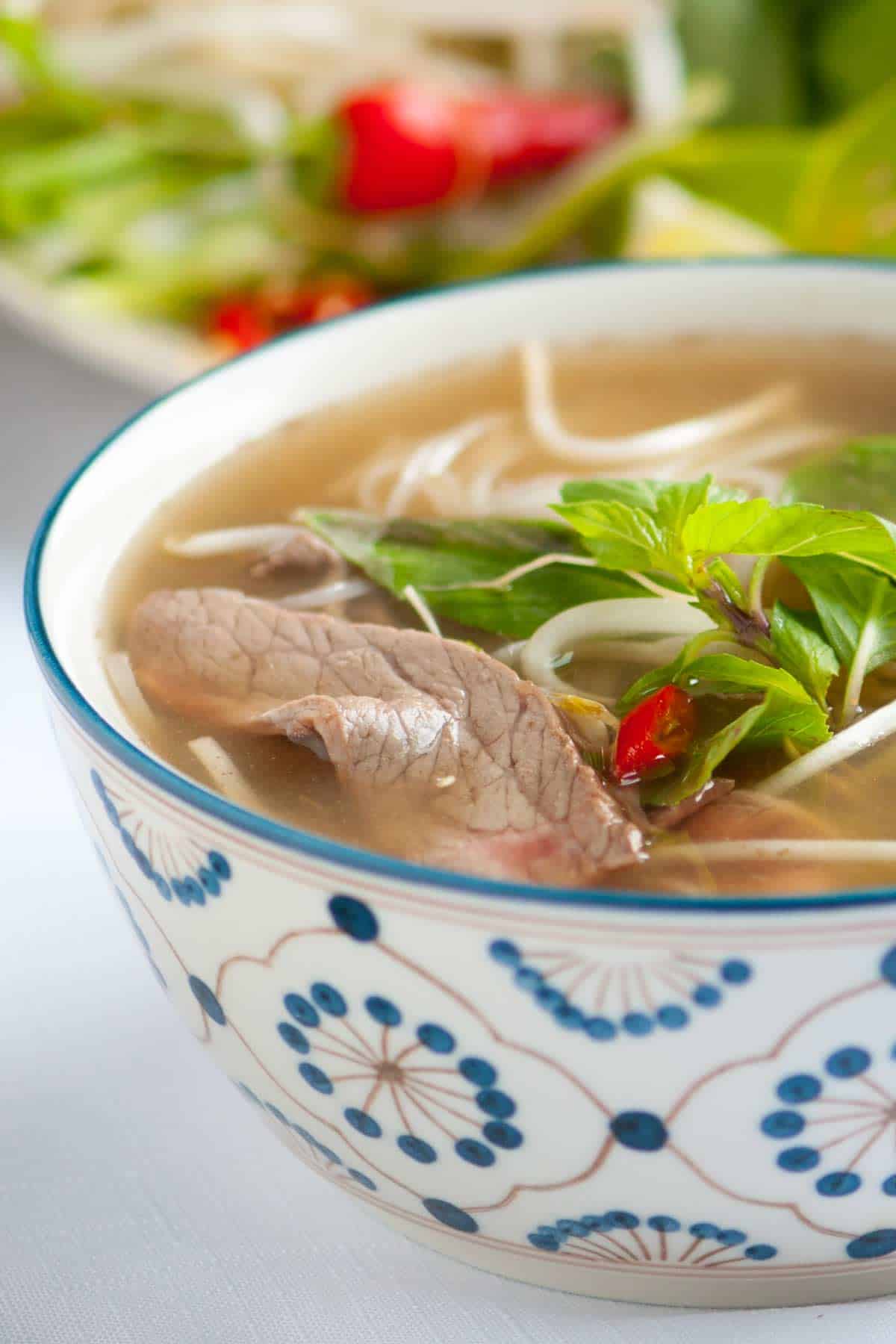
Pho (pronounced “fuh”) is a Vietnamese noodle soup originating in northern Vietnam in the early 20th century. Since then, it has spread across the globe, becoming one of the world’s most beloved noodle soups. One taste, and you’ll see why. If you haven’t tried it, Vietnamese pho is savory, deliciously aromatic thanks to ginger and star anise, and unbelievably comforting.
Every time I make this authentic beef pho recipe (phở bò), I want to make it again. It takes some time, but it’s mostly letting it simmer on the stove (the aroma is irresistible). We first learned how to make pho many years ago and are so happy that we did. So, even if you’ve never made pho before, you can do it, and after one bowl, I’m betting you’ll be so happy that you did!
Key Ingredients
Beef Bones: The secret to the best, most flavorful pho is to simmer bones rich in collagen and marrow for 3 hours. I love knuckle and leg bones for pho, but you can mix and match what’s available. Neck, marrow, knuckle, and leg bones are all excellent options.
I make a note below in our recipe, but one trick we learned for pho is to par-boil the bones before simmering them for our broth. It feels a little odd since you’ll fill a pot with the bones and water, bring it to a boil, and then dump all the water down the drain. Many of our readers worry this is getting rid of flavor for your broth, but it isn’t. The flavor comes much later after a few hours of simmering. Par-boiling simply helps clean the bones of any impurities that would muddy the flavor or color of your broth. You can watch me do it in our video!
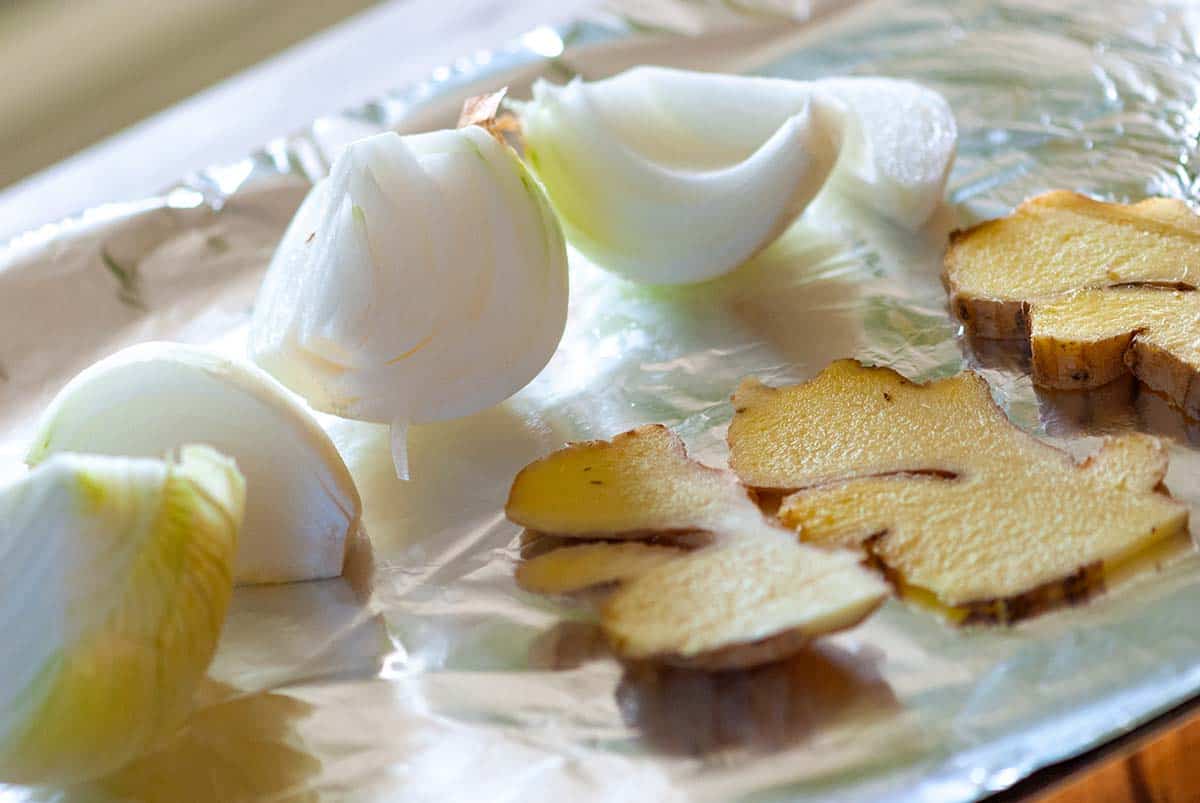
Onion and Fresh Ginger: To get that distinctive, smoky flavor of traditional beef pho, you’ll want to char the onion and ginger before simmering them with the bones. It’s a simple step that adds incredible flavor and a bit of color to our broth. Basically, you’ll lay onion and slabs of ginger on a baking sheet and broil them until charred around the edges. (see the photo below, and watch me do it in the video). Then, add them to the stockpot with your parboiled bones.
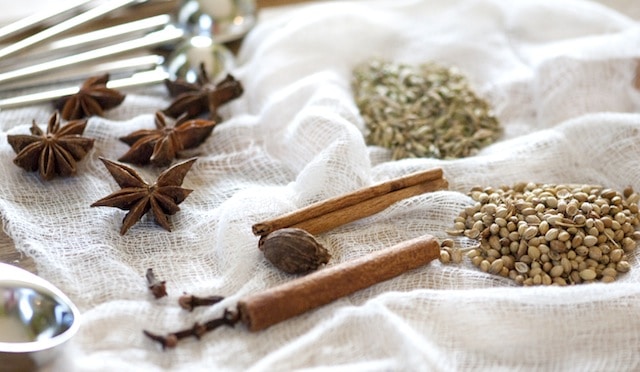
Pho Spices: Beef bones add incredible savory flavor, but it’s the spices that really make the best pho. The aroma of the spices simmering in our broth is intoxication. Our pho recipe calls for cinnamon, whole coriander seeds, fennel seeds, star anise, cloves, and a black cardamom pod. If you do not have these in your spice cabinet, you may have success at an Asian market where I’ve often seen spice packets for pho. The most unusual spice I listed is black cardamom, which I’ll admit I’ve only really used for this recipe. That said, if you can find it, it’s so worth it! I’ve seen it in Asian markets or online. It’s very smoky, and even though we only add one pod, it adds so much to the flavor of our pho.
Fish Sauce: You can’t make pho without fish sauce. You’ll use it when cooking and serving the broth. Andrea Nguyen of Viet World Kitchen suggests that when shopping for fish sauce, look for glass bottles, not plastic, and allow price to guide you. Go for the mid to high-priced fish sauce (which will run you $8 to $15). Two brands of pho we have in our kitchen are Three Crabs and Red Boat.
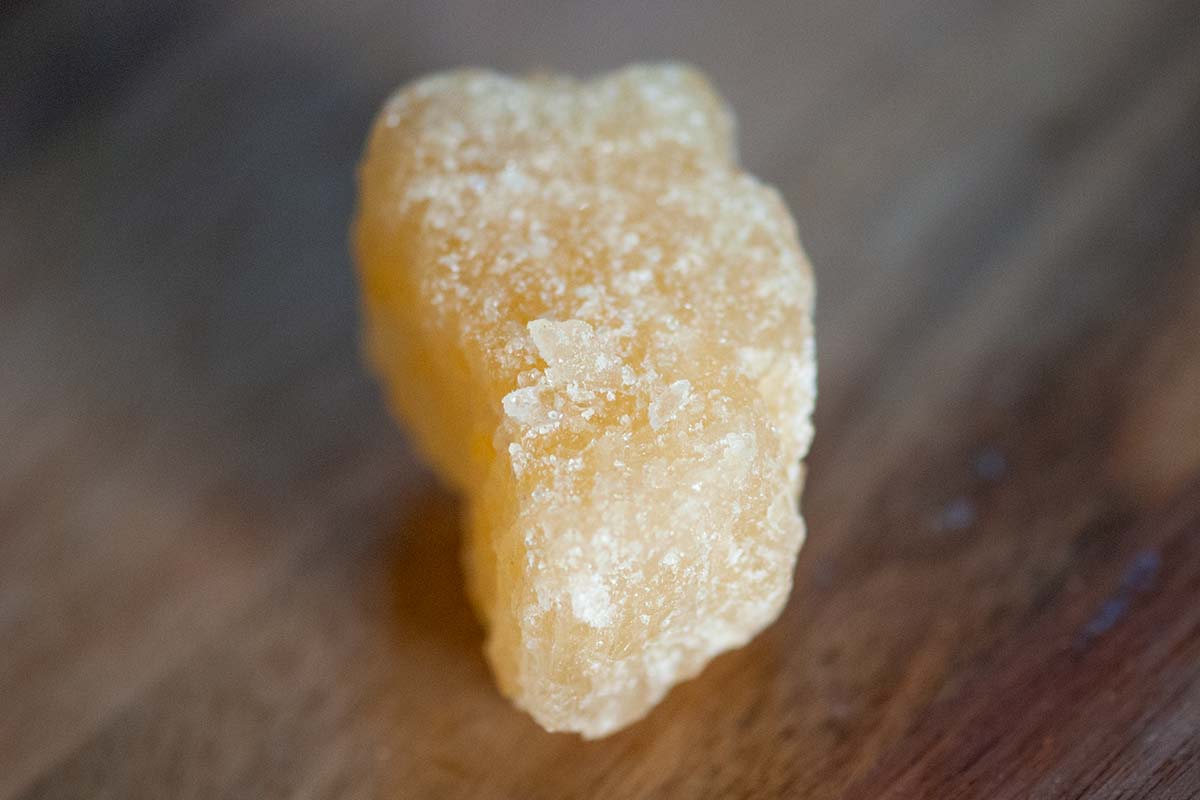
Rock Sugar: Sugar balances the savoriness of our beef broth. I use yellow rock sugar for traditional pho, which I buy at a local Korean market (it is also sold online). If you cannot find it, you can use regular sugar. The flavor is not exactly the same, but it works. (Rock sugar does a better job at rounding out the flavors.)
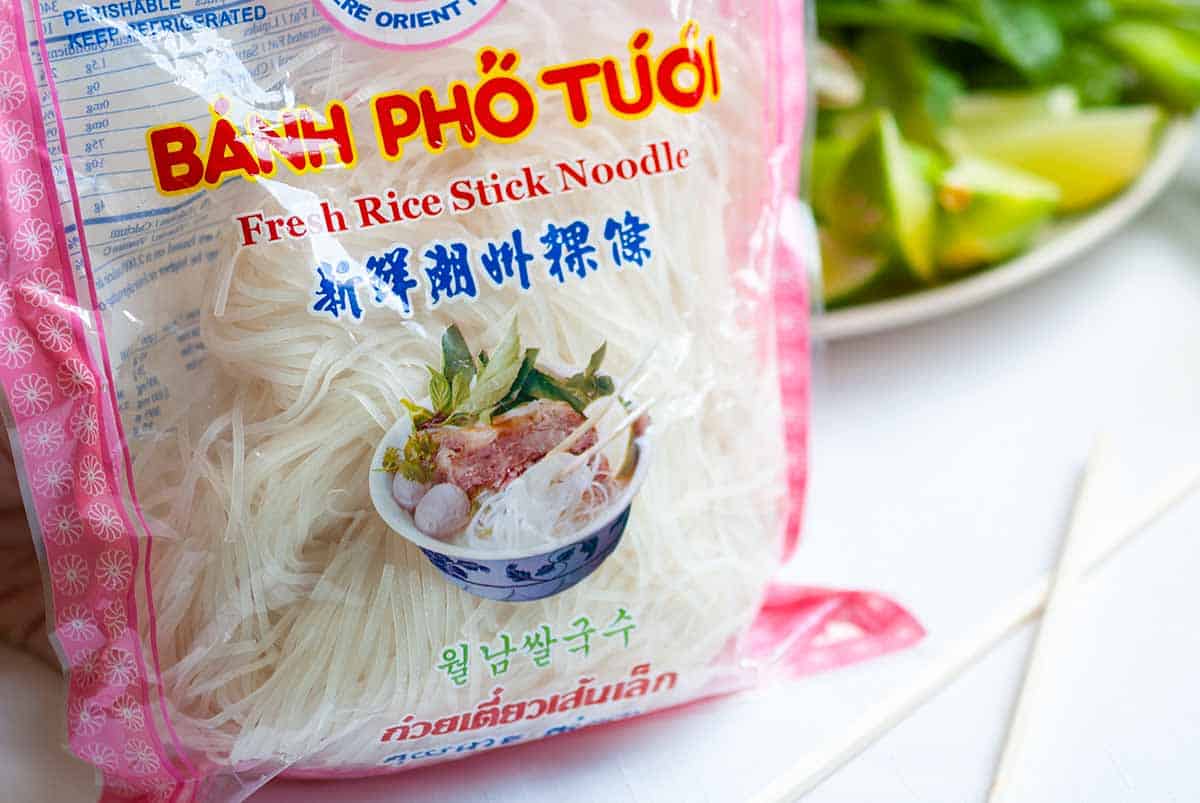
Noodles: Use flat rice noodles for pho, also known as bánh phở in Vietnamese. Rice noodles are delicate and a little chewy, made from rice flour and water. I use the noodles that are around 1/4-inch wide. You can buy fresh noodles at Asian markets (pictured below), which is a nice treat, but dried rice noodles work nicely.
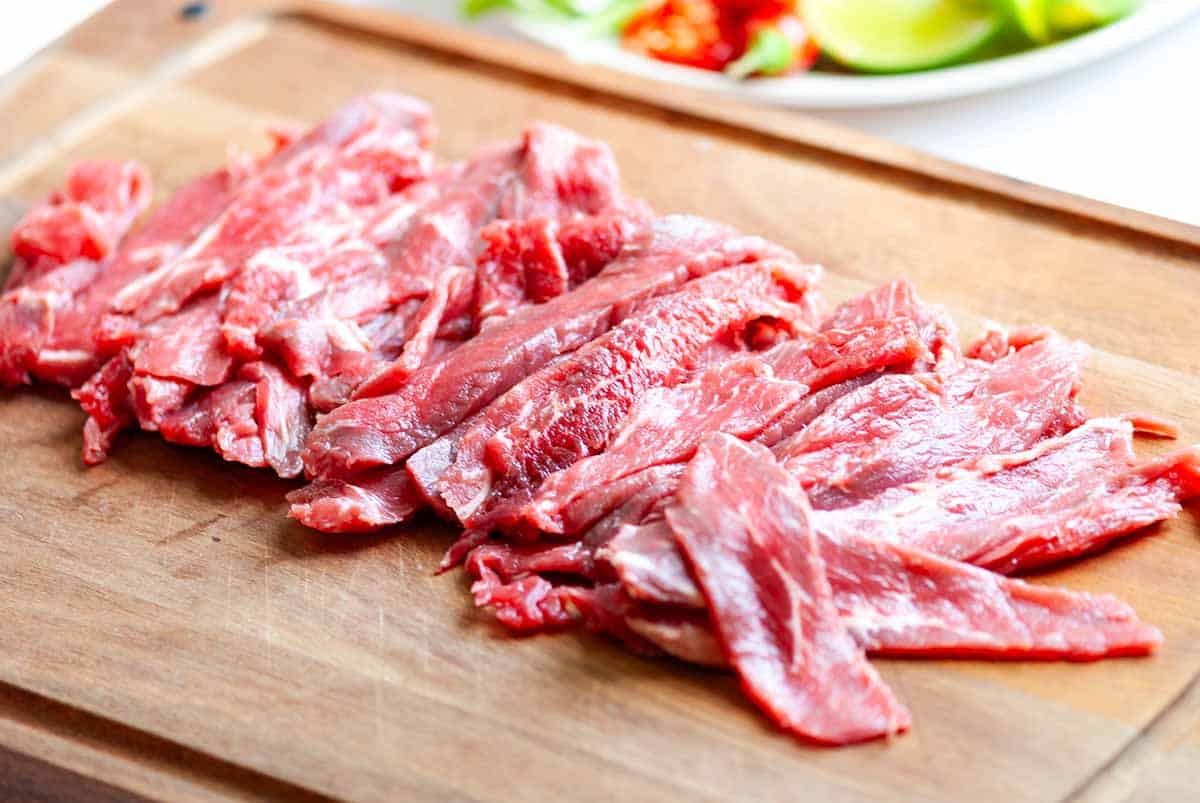
Beef for Serving: In traditional Vietnamese pho, thinly sliced raw beef is often added to the serving bowls before pouring over hot broth. The heat of the hot broth gently cooks the thinly sliced raw beef to a tender medium or medium-rare, depending on the broth’s temperature. You can use cooked beef instead or leave it out (the soup is still delicious without extra meat).
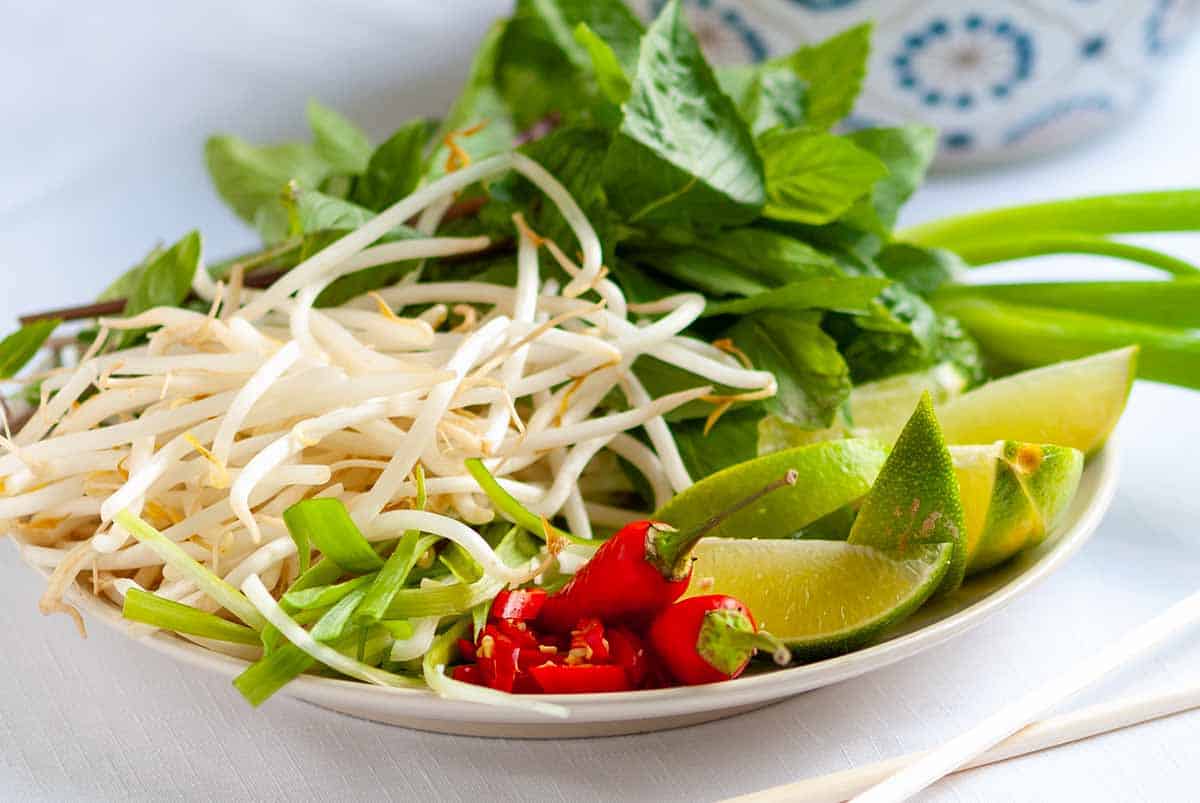
Toppings for Pho: If you’ve ordered pho at a Vietnamese restaurant, then you know one of the most exciting things about it is the plate of optional toppings that comes with your big bowl of pho! We serve pho soup next to a plate of Thai basil, fresh mint, thinly sliced onion, crispy bean sprouts, and lime. Fresh chilies are also lovely! You can also keep fish sauce, Asian chili sauce, and hoisin sauce nearby.
How to Make Pho
Making homemade pho takes some time, but most of that time is hands-off. You’ll spend most of your hands-on time in the first 40 minutes, and then it’s sitting back while the broth gently simmers.
The first thing I always do when making pho at home is parboil my beef bones. It’s easy and helps achieve a crystal-clear pho broth. Toss the bones in your stockpot, add water, and boil for a few minutes. As the bones simmer, they release impurities, making the water scummy and foamy. Strain the bones and rinse away all the frothy scum from them and the pot (watch me do this in the video).
The second tip for the best homemade pho is to toast your spices. Toasting them wakes them up and makes them even more aromatic. Toss them into a dry pan over medium heat, stay close, and shake them around several times. You’ll know when they’re ready when you start to smell them. It only takes two to three minutes.
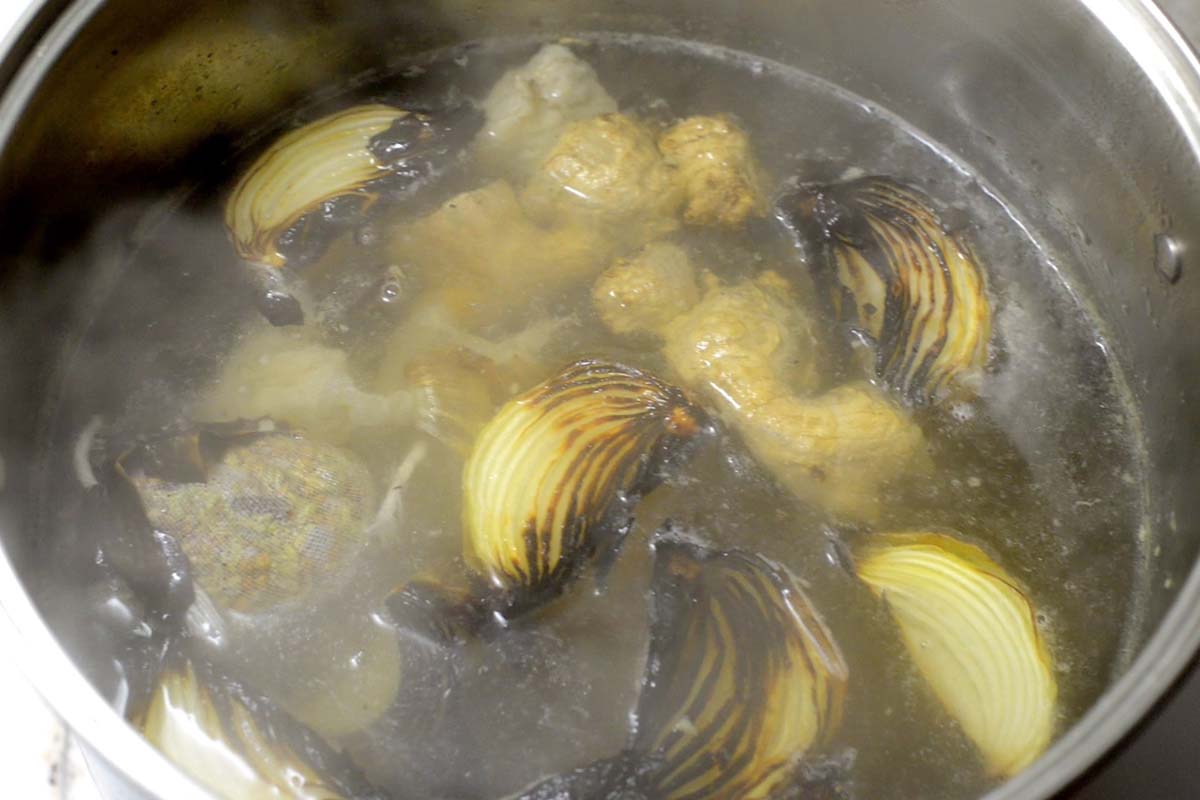
Now it’s time to make the broth! Cover the parboiled bones with water, and add the charred onion and ginger, toasted spices, salt, fish sauce, and rock sugar. The broth will cook at a very low, gentle simmer for about 3 hours, and then you are ready to serve! Before serving, I like to taste my broth and then adjust the seasoning with more salt, sugar, or fish sauce as needed.
When your broth is done, you can strain and get your bowls ready! To assemble the bowls, cook your noodles in a separate saucepan (never in the broth), rinse them, and divide them between serving bowls. Place raw or cooked beef on the noodles, then ladle the simmering broth over them.
Serve immediately with your favorite toppings, such as fresh herbs, bean sprouts, and lime. I hope that’s helpful! Remember, we have a full-length video walking you through this process, so if you are hesitant, make sure you hit play!
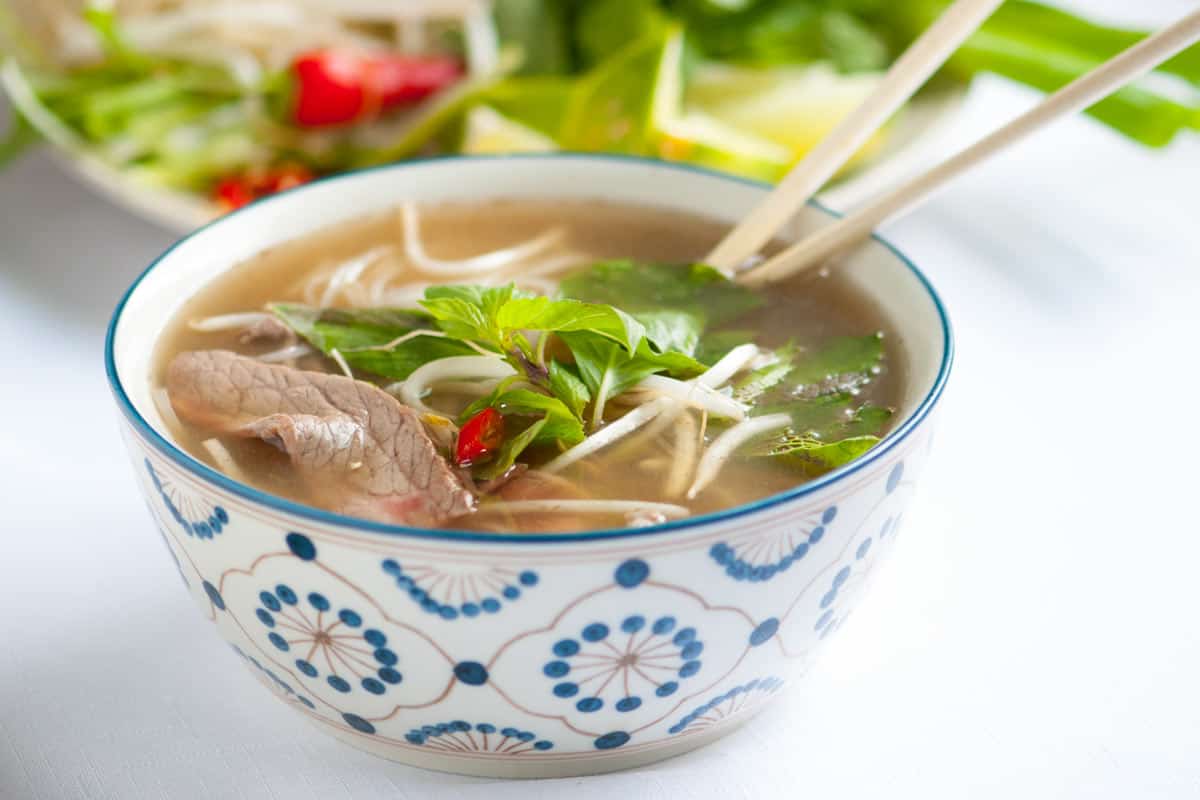
Vietnamese Pho (Homemade Broth!)
- PREP
- COOK
- TOTAL
Making Vietnamese pho at home is easy, especially with our traditional pho recipe. We realize our from-scratch recipe may look daunting, but it’s easier than you think, and there is a lot of inactive time while you wait for the broth (we’ve just been extra tedious to share everything we know).
A few notes before you begin: (1) Parboiling the bones makes our broth clear, and you do not lose any flavor. (2) Keep your broth at a low simmer. Otherwise, it will reduce too much. If it seems that it is reducing too quickly, partially cover the pot with a lid. (3) There will be a generous amount of fat at the top of the broth when it is done. Skim it away with a spoon, or refrigerate the broth overnight. The fat rises to the top and solidifies, making it really easy to remove.
Watch Us Make the Recipe
You Will Need
Pho Broth5 to 6 pounds of beef knuckles or leg bones
6 quarts cold water
2 onions, quartered
4-inch piece of fresh ginger, halved lengthwise
2 cinnamon sticks
1 tablespoon coriander seeds
1 tablespoon fennel seeds
6 whole star anise
6 whole cloves
1 black cardamom pod
1 ½ tablespoons fine sea salt
1/4 cup fish sauce
1-inch piece of yellow rock sugar
Assembly1 pound dried or fresh “banh pho” noodles
8 ounces raw eye of round, sirloin, or tri-tip steak, thinly sliced across the grain
1/4 cup thinly sliced onions
1/4 cup chopped cilantro leaves
Optional for the table: fresh mint, Thai basil, bean sprouts, lime wedges, sliced green or red chilies, fish sauce, hoisin sauce, sriracha or chili sauce
Directions
- Make the Broth
1Place beef bones in a stockpot (10-quart or larger). Cover with cold water. Bring to a boil over high heat for 3 to 5 minutes. As the bones boil, scum and foam will float to the top. Drain the bones, rinse with warm water, and scrub the stockpot clean. Return bones to the pot and add 6 quarts of cold water.
2Preheat oven broiler to high. Line a baking sheet with foil. Place onion quarters and halved ginger on the baking sheet and broil for 10 to 15 minutes, turning occasionally until nicely charred.
3Place cinnamon, coriander, fennel, star anise, cloves, and cardamom pod in a dry frying pan over low heat. Toast for about 5 minutes, stirring occasionally, until fragrant. Transfer the spices to a muslin bag or cheesecloth and seal with twine.
4Bring the stockpot to a boil, then reduce heat to a gentle simmer. Add the charred onions, ginger, spice bag, salt, fish sauce, and rock sugar. Gently simmer uncovered for 3 hours, skimming off any foam that rises to the surface.
5Use tongs to remove bones, onions, and ginger. Strain the broth through a fine-mesh strainer. To remove the fat, skim it off with a spoon or refrigerate the broth overnight (the fridge solidifies the fat at the top, which is easy to remove in the morning).
- Assembling Pho
1Place the strained broth into a stockpot and simmer over medium-low heat while you prepare the noodles.
2To prepare the noodles for cooking, place dried pho noodles in a bowl and cover with hot water. Soak for 15 to 20 minutes or until they are soft and opaque. If you have fresh noodles, do not cover them with hot water. Add them to a colander and rinse with cold water.
3Bring a medium saucepan of water to a boil. Add noodles and cook briefly (about 10 seconds) until they soften. Drain the noodles and divide them evenly between serving bowls, filling each bowl about 1/3 of the way.
4Arrange slices of raw meat over the noodles in each bowl. Carefully ladle the very hot broth over the meat, cooking it gently. Top with onion slices and cilantro. Serve with your favorite pho toppings at the table.
Adam and Joanne's Tips
- Equipment: Large stockpot (10-quart capacity or larger), baking sheet, skillet, Muslin bag/herb sachet or cheesecloth with twine (for spices), and fine-mesh strainer
- Black cardamom pod: Highly recommend for it’s smoky flavor, but optional. Find in International and Asian markets or online.
- Yellow rock sugar: Also known as “lump sugar” sold in boxes at Asian markets. Break into smaller chunks – use a hammer or rolling pin.
- Raw beef: Ask your butcher to thinly slice or place beef into the freezer for 15 minutes to harden a little. Carefully slice the beef across the grain into 1/16-inch thick slices.
- Storing the pho broth: Homemade pho broth lasts in an airtight container in the fridge for up to 5 days. To freeze, transfer to freezer-friendly containers and freeze for up to 6 months. Thaw frozen pho broth in the refrigerator overnight and reheat the next day. To reheat, add to a saucepan and bring to a simmer before pouring into your serving bowls. We do not recommend storing/freezing cooked noodles, as they tend to break up over time.
- Can I use store-bought beef broth? If you want to make pho as good as you’d find at the most authentic restaurants, substituting store-bought beef broth for this recipe won’t cut it. We know our process takes longer than some, but trust me, this homemade Vietnamese pho broth has so much more flavor. You won’t regret it.
- Recipe inspired by Andrea Nguyen of Viet World Kitchen and Jaden Hair of Steamy Kitchen.
- The nutrition facts provided below are estimates.

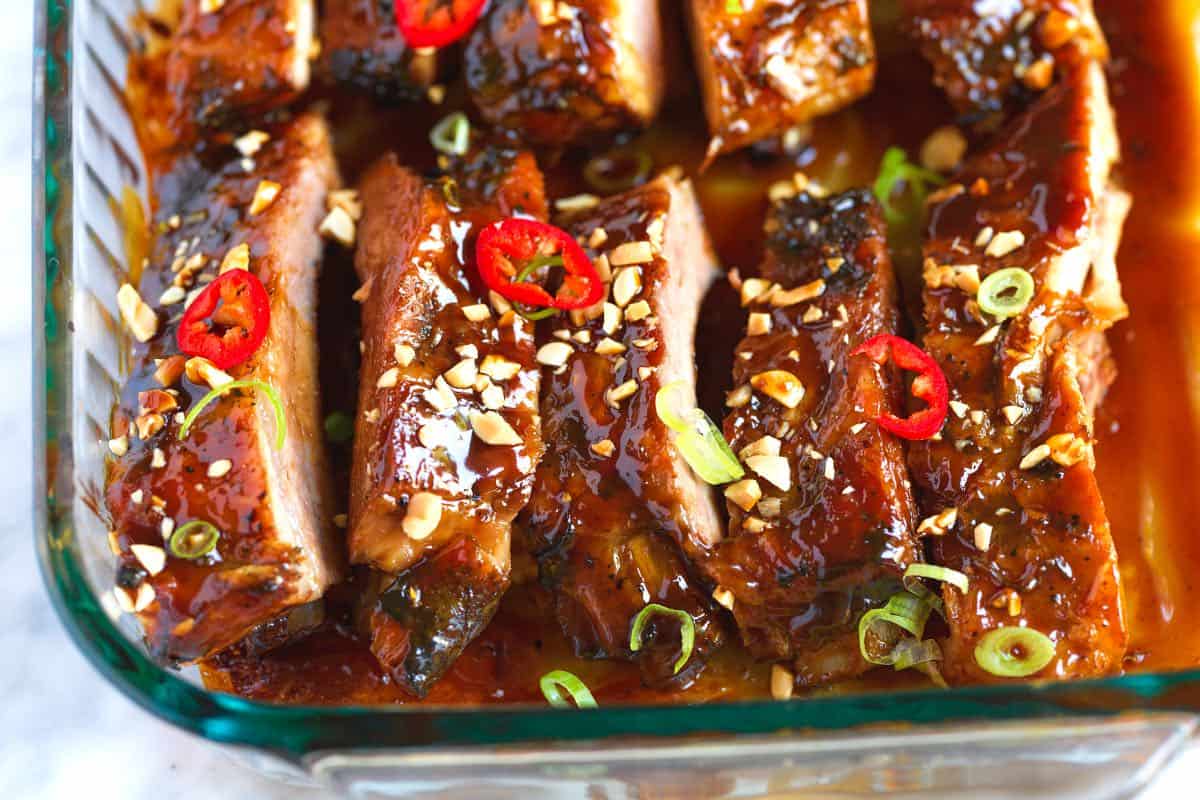
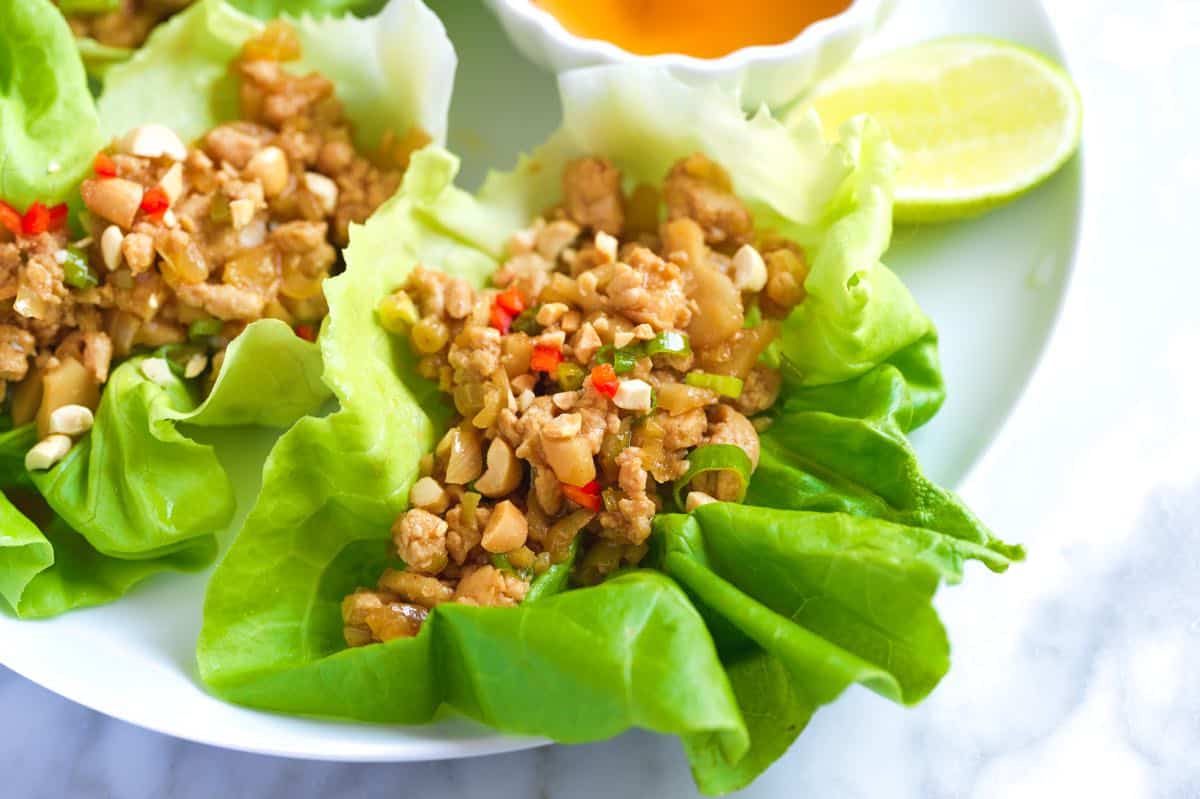
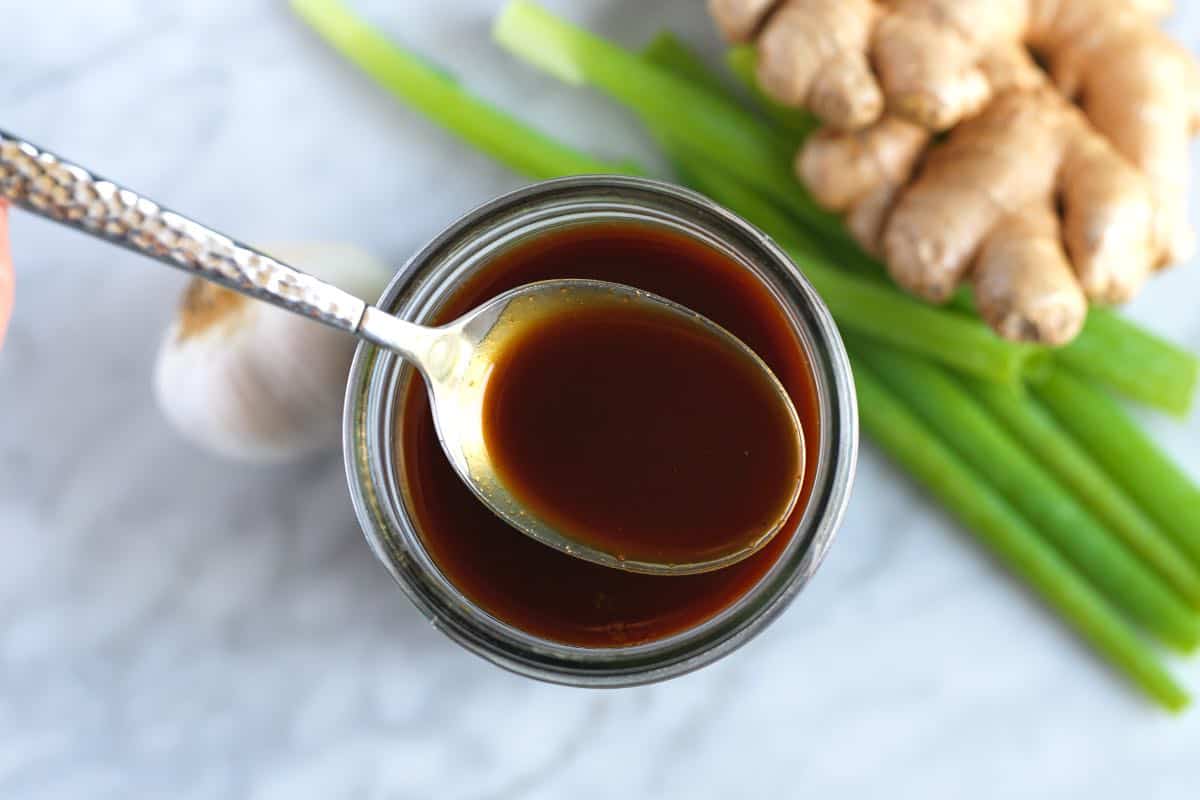
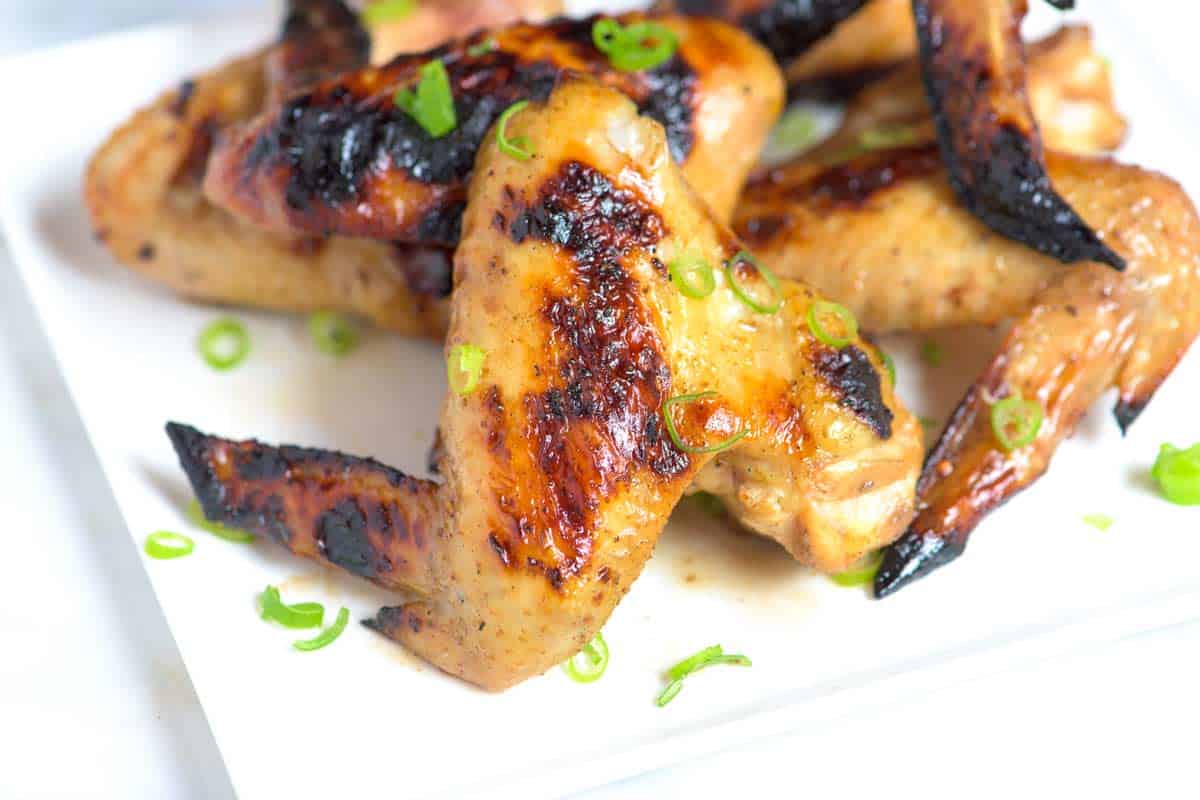
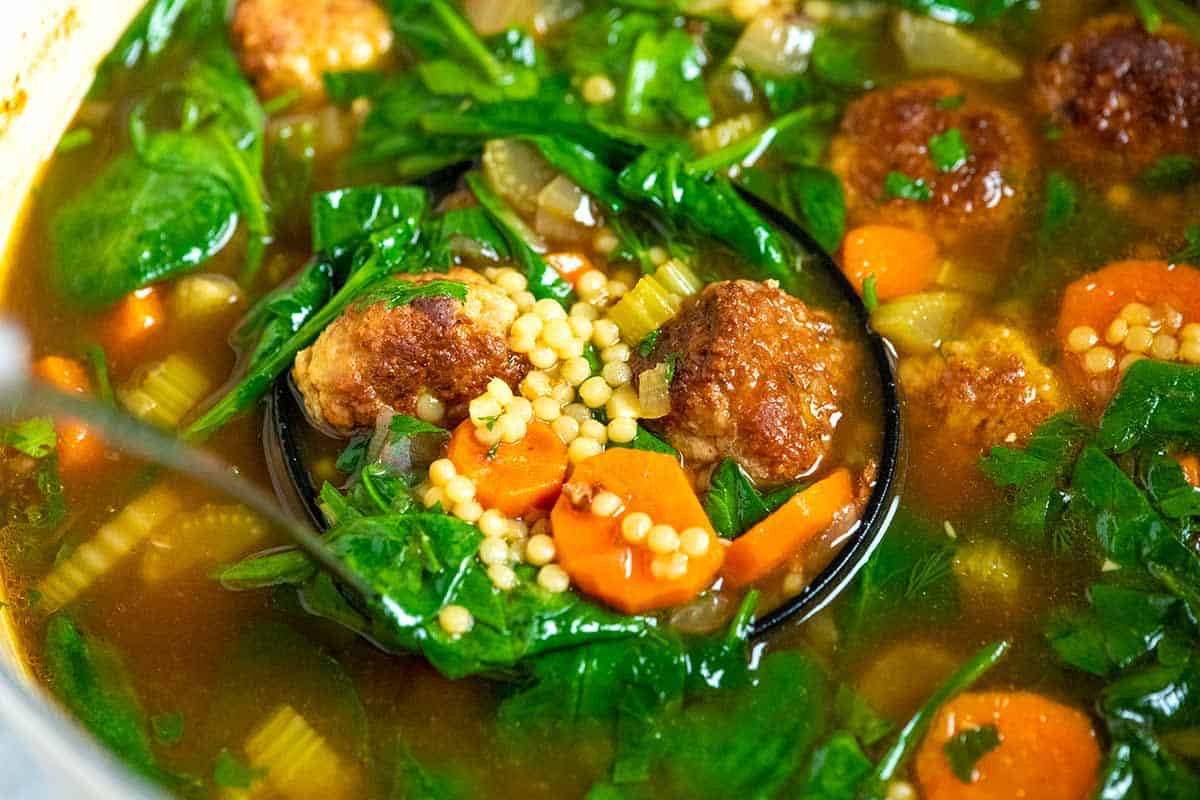
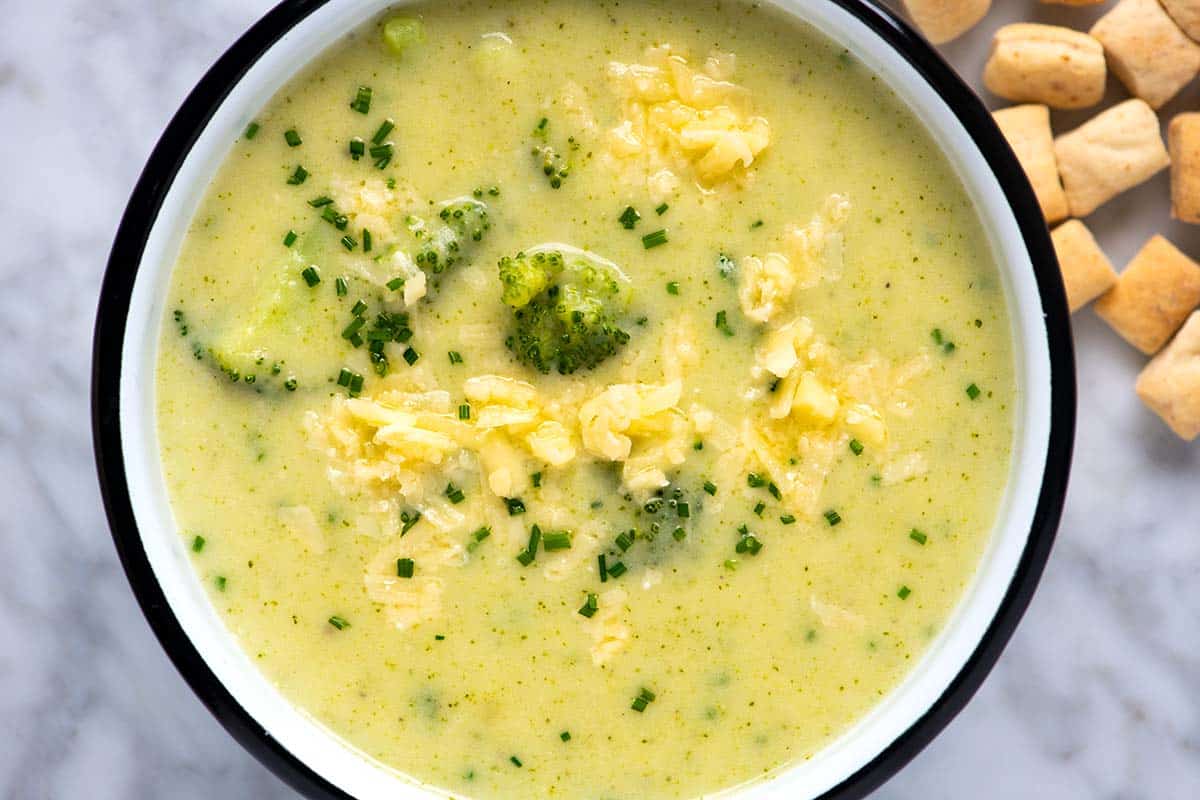


Is the assembly for all 4 bowls or one?
All 4 bowls.
I made this last night, I found it to be clean with complex flavors. Great Job with the recipe.
How many servings does this make?
This makes 4 generous bowls.
So I am currently making this, but while at this Vietnamese store the owners wife told me to leave for 24-48 hrs simmering. Why 3 instead of 24hrs?
Hi Abe, Simmering pho for 3-4 hours creates a flavorful delicate broth. Longer simmering (24-48 hours) extracts more collagen, resulting in a richer broth, which is how some traditional pho restaurants achieve their signature texture. The thing to keep in mind is that our recipe has been developed for the shorter simmer time, so if you were to simmer for longer, you will need more water to start with.
Can Old Man Que Huong Pho Bac Spice Seasoning replace the seasonings list on this recipe? If so, how much would I use? Thank you, Can’t wait to make this and post a review!
Hi B, we haven’t tried that spice blend before but it does get great reviews. It looks like it is missing a couple spices from our ingredient list but it should work nicely 🙂
Hi just an fyi that old man pack worked great. I use it all the time.The recipe on this site is awesome.
Is the reason for a three hour simmer because of the bones? Or the ingredients need that much time to get into the broth in general. If I were to use ready to go bone broth/stalk do I minamize the time for it to simmer or it’s still three hours ? I want to make this but of course sometimes I’m in a time crunch!
Hi Kim, Yes, simmering for 3 hours is to get flavor out of those bones. If you use store-bought broth, you can leave out the bones and make a “Faux pho” by adding the aromatics (spices, ginger, onion, sugar, etc…) to the broth and simmering for 20-30 minutes. The Pho will not taste as authentic, but it is your best bet for a quicker soup.
I’ve been looking for a recipe for pho. After reading the comments I’m definitely going to make it. Considering we spent $90 for four people at a Thai restaurant last week. Off to the Asian market!!
Great recipe! Others I’ve seen took way too long. I tend to simplify things and don’t always do the first step, but will strain everything near the end. I love the pho spices. Also found that my Wal-Mart is selling packages of shaved beef that worked great in this recipe (rib eye).
I saw this recipe a few weeks ago and was determined to make it! I bought all the ingredients and it’s simmering as we speak. It smells AMAZING and I cannot wait to try it
Yay! That makes me so happy to hear. The aroma of pho is truly something special. I bet your house smells incredible – definitely the best part of the process! Can’t wait to hear how you like it.
This recipe was so delicious. I used beef spare rib bones. I purchased them as part of a precooked meal at the Korean grocery. Since they were already cooked once I skipped the 1st step when boiling. I didn’t have a cheese cloth so I just strained everything out at the end and the flavor was still perfect. I also made this as a more soup base so tonight I added bok choy, jalepeno, diff types of mushrooms and vermicelli. If I get to the store I’ll get the fixings just for pho because this broth turned out way better than even my local Vietnamese place so I want to try the full flavor of the thin beef and so on in this broth!! Thanks again!
Love it! Your description made me want to make it this weekend 🙂
Thanks for the recipe! It was terrific! I used pork bones as that was what was available. I think the seasonings were for beef but I used what was in the recipe for an incredible aroma and delicate but roboust broth that was well worth the time. We so enjoyed this. I served this with pork spare ribs that I slowed cooked and then broiled and placed over the noodles and broth. This is now a faviorite. Thank you for the recipe and time spent on instructions to get it just right!
Thank you for your generosity. It is impossible not to succeed in making the recipe, with all your detailed explanations and with the video. The soup turned out wonderful.
You are very welcome. We are so glad that all of the details and video are useful 🙂
I haven’t tried it but I have a question first. Are you able to reuse the spices at all after making the broth?
Since they will be wet from the broth, I’d toss them out. They simmer for a while in the broth so they definitely have given their love.
This recipe was FANTASTIC and practically foolproof. We were able to get some oxtail, and I served that meat along with the soup, all the accoutrements, the eye of round, and the noodles. My local Asian market had pretty much everything we needed, and yes, buying some spices, etc., is a small investment, but compared to taking 4-6 people out to a restaurant, this recipe was a steal! We are so full and happy! Thank you for the wonderfully detailed recipe and all the tips and tricks!
Yay! Thank you so much for coming back to leave this wonderful review 🙂
This was amazing!! It was really quite easy, albeit time consuming. I was so proud of how it turned out. Totally authentic flavor. Keeping this recipe for next time. Thank you for the tips too!
I’m making this today. Purchased everything in the last few days. I’m not the best ingredients I could find to duplicate it. About $150 worth